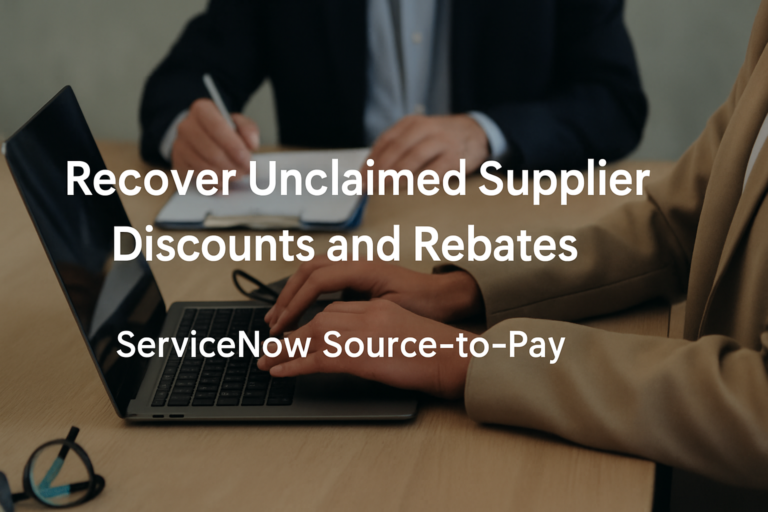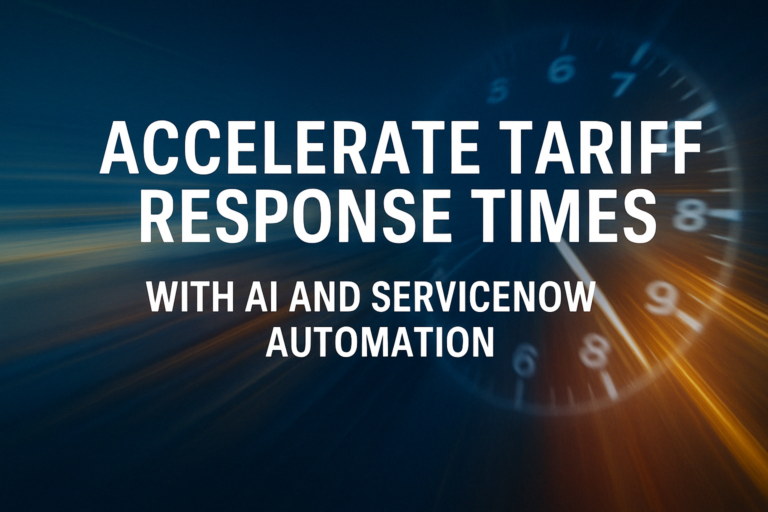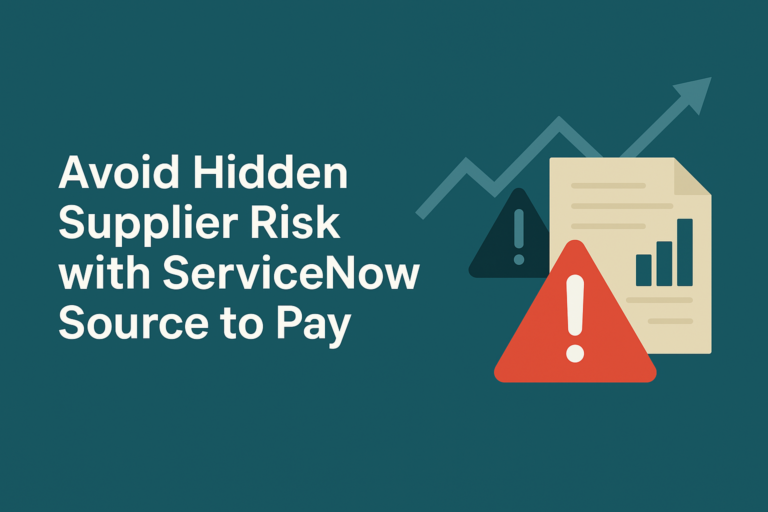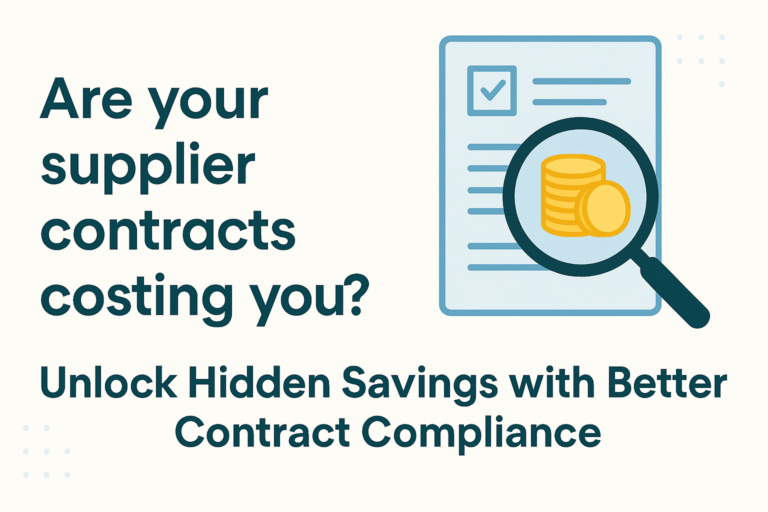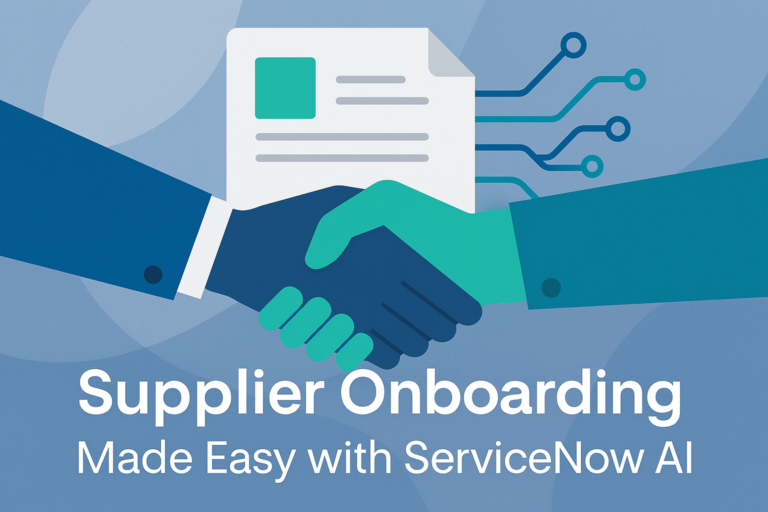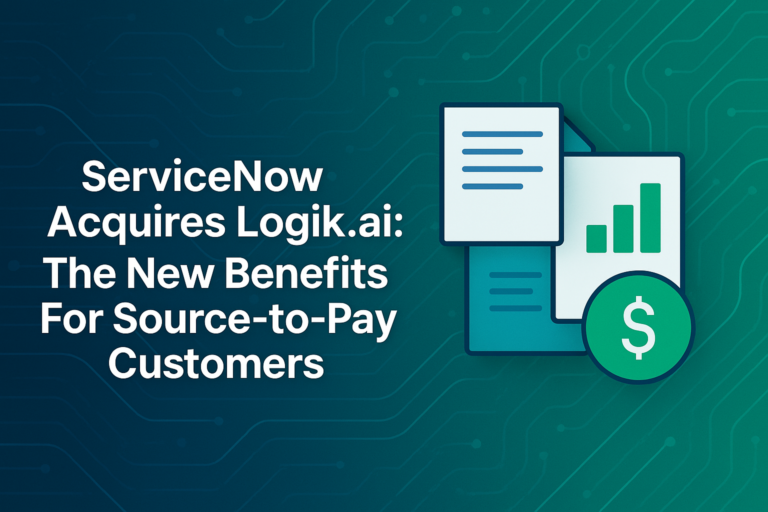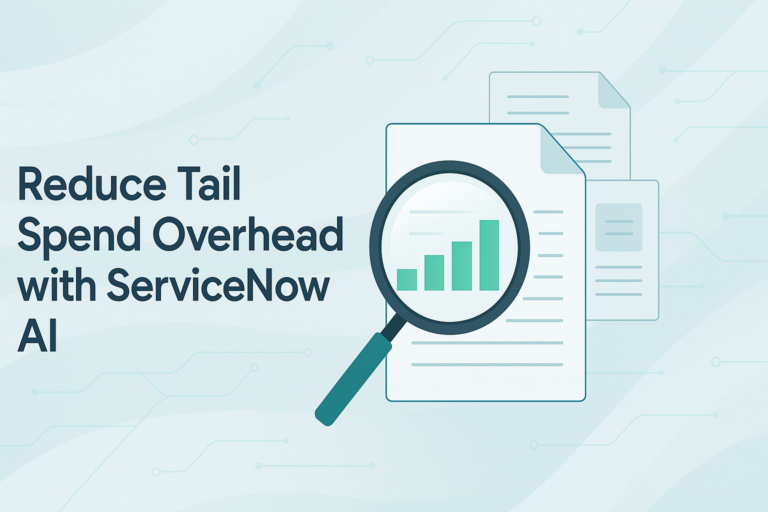Supplier Compliance Simplified with ServiceNow
ServiceNow Supplier Lifecycle Operations helps automate supplier compliance, making it a key component in building a resilient supply chain.
Defining Supplier Compliance
Supplier compliance has become a critical focus for procurement and supply chain professionals in today’s complex global landscape. Organizations face increasing pressure to ensure that every supplier adheres to documented standards and complies with contractual and legal obligations, from certificates of insurance (COIs) to regulatory licenses. However, the manual processes often used for compliance checks can be time-consuming, prone to errors, and costly.
Automating supplier compliance processes can significantly reduce administrative burdens and enhance overall risk management. This allows organizations to respond quickly to compliance breaches, global regulations, and shifting market demands. Businesses can standardize workflows and maintain real-time visibility into supplier credentials, risk profiles, and performance by utilizing document automation, OCR technology, and self-service supplier portals that are part of ServiceNow Supplier Lifecycle Operations.
This article discusses some of the challenges teams face around supplier compliance and how automation can streamline and optimize compliance management. Our goal is to help organizations build a more resilient, efficient, and transparent procurement function regardless of size or industry.
Supplier compliance refers to the comprehensive policies, procedures, and activities that ensure external vendors and service providers meet an organization’s regulatory, contractual, and ethical standards. Key aspects of compliance verification include:
1. **Insurance Coverage**: This involves the assessment of valid certificates of insurance (COIs), which include workers’ compensation, liability limits, cybersecurity insurance, and more, to ensure adequate protection against potential risks.
2. **Licenses and Certifications**: Organizations must verify that their suppliers possess the necessary business licenses, ISO certifications, financial qualifications, and credentials related to safety and quality management.
3. **Regulatory Requirements**: Suppliers should demonstrate compliance with relevant regulations such as the General Data Protection Regulation (GDPR), data privacy protections, environmental regulations, and product safety standards.
4. **Contractual Stipulations**: It is essential to ensure that vendors adhere to the terms outlined in contracts, including pricing agreements, Service-Level Agreements (SLAs), performance benchmarks, and other negotiated requirements.
Organizations can mitigate risks and foster a responsible supply chain by monitoring and enforcing these compliance metrics.
Why It Matters
Compliance issues are critical in influencing brand reputation and ensuring operational continuity. Even a single oversight, such as a missed insurance renewal, an expired license, or a failure to meet data protection regulations, can result in significant consequences, including fines, legal liabilities, and damage to reputation. Additionally, non-compliance among suppliers can disrupt the supply chain, leading to halted production lines, delayed projects, and diminished consumer confidence.
In today’s globalized economy, businesses often depend on a diverse network of suppliers across various regions, each governed by distinct labor laws and market regulations. Implementing a strong compliance management framework, particularly one that leverages automation, allows procurement teams to navigate this complexity effectively. This approach minimizes the risk of oversight and significantly reduces the costs associated with manual, repetitive tasks.
Key Risks of Non-Compliance
Reputational Damage
The public scrutiny of supply chain practices is at an all-time high. Vendors that are non-compliant or unethical expose themselves to detrimental media coverage, eroding stakeholder trust and consumer loyalty. Additionally, companies that do not adequately ensure supplier compliance may be perceived as neglecting their social and legal obligations.
Financial and Legal Penalties
Fines associated with data breaches, environmental violations, or breaches of contract can be substantial. For example, the General Data Protection Regulation (GDPR) enforces hefty penalties for failures in data protection. Additionally, depending on the specific industry, other regulatory agencies—such as the Food and Drug Administration (FDA) in the United States or the Medicines and Healthcare Products Regulatory Agency (MHRA) in the United Kingdom—can impose enforcement actions in cases of supplier non-compliance.
Supply Chain Disruptions
Every vendor plays a crucial role in shaping processes in any operational framework, whether tail-spend suppliers offering low-cost goods or strategic partners collaborating on high-stakes projects. The absence of complete or valid documentation can create unforeseen challenges, leading to significant delays that require immediate attention and swift action. Disturbances within the supply chain can trigger a domino effect, spreading disruptions throughout the entire network and potentially resulting in costly setbacks that impact overall efficiency and productivity.
Higher Operational Costs
Inefficient manual processes for managing compliance—such as tracking down missing documents, following up with suppliers for renewals, and double-checking forms—consume valuable operational resources. As a result, procurement teams often miss opportunities to focus on more strategic tasks like supplier performance management, negotiation, and innovation.
Benefits of Automating Supplier Compliance
Real-Time Visibility and Control
An automated system provides procurement and compliance teams with centralized dashboards showing suppliers’ status. This includes whether suppliers are fully compliant, nearing document expiration, or in violation of specific requirements. Real-time notifications allow for swift mitigation strategies, such as blocking non-compliant suppliers from receiving new purchase orders until they make the necessary updates.
Reduced Administrative Overhead
Automated compliance workflows eliminate manual, error-prone tasks by utilizing self-service supplier portals and automated notifications. For example, suppose a Certificate of Insurance (COI) is about to expire. The system can automatically mail the supplier several days in advance, followed by additional reminders as the expiration date approaches. This proactive approach ensures compliance is maintained without burdening staff with repetitive outreach tasks.
Faster Supplier Onboarding
When onboarding a new marketing agency, IT vendor, or raw materials supplier, incorporating compliance checks into your workflow can speed up the time it takes to realize value. Using automated data capture methods, such as OCR or electronic forms, along with integrated document verification, allows for the quick approval of new suppliers. This approach minimizes bottlenecks while ensuring thorough due diligence is maintained.
Consistency and Accuracy
Mistakes and omissions often happen when compliance tasks rely on spreadsheets or manual input. An end-to-end digital platform ensures consistency by requiring all suppliers to adhere to the same processes and documentation standards. Built-in checks, such as mandatory fields and data validation rules, improve accuracy and guarantee that all captured data is reliable and up-to-date.
Audit Readiness
In some industries, audits are a regular occurrence. Automated compliance solutions keep detailed records, time stamps, and audit trails. Any historical compliance check can be retrieved instantly, such as verifying whether a license was current at a specific date. This level of documentation drastically reduces time spent preparing for audits and reduces the risk of compliance lapses being discovered too late.
Technology Enablers for Supplier Compliance Optimization
Supplier Portals
Supplier self-service portals enable vendors to manage their own information, including updating addresses and contact details and uploading compliance documents. These portals decentralize data management and reduce administrative burdens for procurement teams. A user-friendly and intuitive portal encourages higher adoption rates among suppliers, ensuring that vendors are motivated to update their documents before they expire.
Document Management and OCR
Technologies like OCR (Optical Character Recognition) have revolutionized document handling. Instead of staff typing in certificate details, OCR extracts text from COIs, licenses, and various forms—automatically populating relevant fields in the compliance system. OCR technologies – such as DocIntel from ServiceNow – enable faster processing and immediate alerts if something is missing or invalid.
Automated Notifications and Workflows
Intelligent workflows can play a crucial role in capturing and validating information. Automated notifications are sent to suppliers according to a structured timeline: 30 days before a document’s expiration, 15 days after expiration, and so on. This process guides suppliers in taking corrective action. Tasks automatically escalate to a predetermined chain of command if specific thresholds are not addressed in time, triggering further enforcement measures.
Advanced Analytics and Reporting
Compliance analytics can help identify trends, such as the most common reasons for non-compliance and the categories of suppliers that frequently miss deadlines. By recognizing these patterns, procurement teams can improve their policies, provide additional training, or adjust their supply base strategy to reduce future occurrences.
Integrations with Sourcing and Contract Management
A fully integrated ServiceNow platform combines supplier compliance checks with other essential processes, including sourcing events, contract negotiations, and accounts payable invoice processing. A supplier failing a compliance check may block payments or prevent new contract awards until the issue is resolved. This creates a strong incentive for suppliers to maintain full compliance.
Best Practices for Automating and Optimizing Supplier Compliance
Standardize and Centralize Requirements
A leading cause of compliance gaps is inconsistent documentation and requirements across multiple departments. Centralize all supplier compliance requirements into a unified digital repository. Maintain a standardized list of mandatory documents and validation criteria for each vendor type or category.
Action Tip: Develop compliance workflows and playbooks for each supplier category (e.g., strategic suppliers, IT vendors, service contractors, material providers) so that it’s clear which forms, licenses, or insurance certificates are non-negotiable.
Segment Suppliers by Risk Profile
Not all suppliers carry the same level of compliance risk. A mission-critical component supplier or a vendor handling sensitive customer data warrants more stringent checks than a one-off supplier providing office stationery. Use a risk-based segmentation strategy: High-risk suppliers might be required to provide additional credentials (like cybersecurity certifications) and undergo more frequent audits.
Action Tip: Incorporate a risk scorecard that evaluates financial stability, compliance history, geographic location, or the nature of the goods/services supplied. This scorecard can automate classification into tiers (e.g., Low, Medium, and High risk).
Leverage Automated Reminders and Escalations
Automation is most effective when it anticipates user needs. Configure your system to send out advance notifications (30 days, 15 days, etc.) before a certificate’s expiration, followed by repeated “nag-o-matic” reminders. If a supplier remains unresponsive, the system should automatically escalate the issue to the appropriate manager or compliance officer.
Action Tip: Use the ServiceNow Escalation Template to map your escalation matrix. Determine at what interval (and via which communication channels—email, SMS, phone calls) the reminders move up the management hierarchy.
Enforce Clear Penalties for Non-Compliance
Suppliers are less incentivized to act promptly if the system only sends reminders but never imposes real consequences. Actions could include suspending purchase orders, blocking invoice payments, or pausing contract renewal discussions until the compliance issue (s) is resolved. Ensure these protocols are included in contractual agreements and the supplier code of conduct.
Action Tip: Align with legal, finance, and procurement stakeholders to define a uniform penalty process. Consistency is key—ensuring no supplier feels singled out or unfairly penalized.
Integrate with Contract and Sourcing Modules
Supplier compliance is most powerful when integrated into broader workflows. For instance, upon awarding a sourcing event to a new supplier, the system automatically triggers compliance tasks that must be completed before a contract can be executed. Once the contract is active, any compliance lapse can trigger a hold on shipments or payments, protecting the organization from unmitigated risk exposure.
Action Tip: Map the end-to-end journey. Identify critical touchpoints (RFx, contract authoring, onboarding, ordering, invoicing) where compliance checks should automatically occur, ensuring real-time synergy between modules.
Measuring Success with Compliance Analytics
Compliance Rate
One of the most straightforward metrics is the percentage of fully compliant suppliers at any given time. This can be calculated by dividing the number of suppliers who meet all requirements (COIs, licenses, etc.) by the total number of active suppliers. Tracking how this rate changes over time or across different categories is invaluable for understanding the effectiveness of your compliance program.
Turnaround Time for Compliance
Measure how long it takes a supplier to achieve compliance after being requested to supply documentation. Shorter turnaround times indicate that your automation efforts (reminders, self-service portals) are working. Longer times may reveal user experience issues or the need for more stringent enforcement mechanisms.
Renewal Timeliness
When documents expire, do suppliers promptly upload the new versions? Renewal timeliness measures the average lead time before or after expiration that a document is updated. A strong performance here signals that your automated notifications effectively drive supplier behavior.
Cost Reduction
By implementing automation, organizations often see a decline in administrative overhead—fewer emails, phone calls, and staff hours spent chasing documents. Additionally, a drop in fines or penalties related to non-compliance indicates successful risk mitigation. Over time, these cost savings can be substantial, providing a strong ROI on compliance automation investments.
Incident Reports and Mitigation Speed
Inevitably, compliance lapses will occur. However, measuring how quickly they’re identified and resolved can highlight the strength of your monitoring systems. Can your organization detect red flags and respond within hours or days rather than weeks or months?
Future Outlook: Evolving Requirements and Continuous Improvement
Global Regulatory Landscape
Regulatory frameworks are becoming increasingly complex and stringent—especially in areas like data privacy, environmental sustainability, and responsible sourcing. Companies must be agile, ensuring their compliance systems can be swiftly updated to meet new regulations. Automated solutions with dynamic workflows and flexible configuration are better able to keep pace.
Supplier Collaboration and Innovation
With compliance tasks handled more efficiently, procurement teams can shift focus toward supplier collaboration and innovation. Instead of getting bogged down in document tracking, your team can explore ways to increase other efficiencies.
AI and Predictive Analytics
While existing automation tools excel at scheduled reminders and document parsing, AI-driven solutions are the next wave of innovation. Predictive models can flag suppliers at higher risk of compliance lapses or spot suspicious patterns that might indicate fraud. As data volumes grow, machine learning can identify correlations in quality control, on-time delivery, and compliance metrics, helping procurement teams refine their strategies.
Continuous Improvement Culture
Supplier compliance is not a “set it and forget it” process. It requires a culture of continuous improvement—regularly auditing the effectiveness of automation workflows, reviewing escalation protocols, and seeking feedback from suppliers and internal teams.
Conclusion
Automating and optimizing supplier compliance is not merely an operational efficiency play—it’s a strategic imperative. The potential benefits are multifaceted:
- Reduced risk of financial penalties and reputational harm
- Improved operational continuity through streamlined document checks and proactive notifications
- Enhanced supplier relationships as administrative burdens diminish and strategic collaboration increases
- Greater agility in responding to new regulations, market disruptions, or shifting enterprise priorities
By leveraging tools like self-service supplier portals, OCR document scanning, automated escalations, and compliance analytics, organizations can transform how they manage supplier compliance—moving from a reactive stance to a proactive, strategic approach. As global supply chains continue to evolve and regulatory scrutiny intensifies, harnessing the power of digital procurement technology will be critical in maintaining a competitive, resilient, and responsible supply network.
Next Steps to Get Started
- Map Your Current Process: Identify where compliance tasks exist (onboarding, contract renewal, ongoing vendor management) and where the most significant pain points lie.
- Set Clear KPIs: Define success metrics—compliance rate, turnaround time, cost savings—to gauge the impact of automation efforts.
- Choose a Scalable Solution: ServiceNow Source-to-Pay integrates compliance management into broader procurement workflows, ensuring real-time visibility and control.
- Collaborate with Stakeholders: Involve legal, finance, IT, and procurement teams early to align requirements and ensure that the chosen solution meets the organization’s broader goals.
- Engage Suppliers: Communicate the benefits of a self-service, automated process, emphasizing how it simplifies their interaction with your organization and reduces delays in payments or purchase orders.
Want to Learn More About Supplier Lifecycle Operations?
Stay tuned for future posts, where we’ll dive into additional strategies for contract management, spend analysis, sourcing optimization, and beyond. If you have immediate questions or need expert guidance, contact us or visit Outcome Driven Solutions for insights on how we help organizations achieve faster, smarter, and more cost-effective Source-to-Pay transformations.



